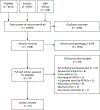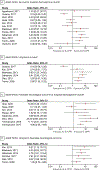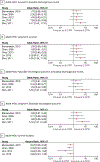Extracorporeal cardiopulmonary resuscitation for cardiac arrest: A systematic review
- PMID: 30063963
- PMCID: PMC6441971
- DOI: 10.1016/j.resuscitation.2018.07.029
Extracorporeal cardiopulmonary resuscitation for cardiac arrest: A systematic review
Abstract
Aim: To assess the use of extracorporeal cardiopulmonary resuscitation (ECPR), compared with manual or mechanical cardiopulmonary resuscitation (CPR), for out-of-hospital cardiac arrest (OHCA) and in-hospital cardiac arrest (IHCA) in adults and children.
Methods: The PRISMA guidelines were followed. We searched Medline, Embase, and Evidence-Based Medicine Reviews for randomized clinical trials and observational studies published before May 22, 2018. The population included adult and pediatric patients with OHCA and IHCA of any origin. Two investigators reviewed studies for relevance, extracted data, and assessed risk of bias using the ROBINS-I tool. Outcomes included short-term and long-term survival and favorable neurological outcome.
Results: We included 25 observational studies, of which 15 studies were in adult OHCA, 7 studies were in adult IHCA, and 3 studies were in pediatric IHCA. There were no studies in pediatric OHCA. No randomized trials were included. Results from individual studies were largely inconsistent, although several studies in adult and pediatric IHCA were in favor of ECPR. The risk of bias for individual studies was overall assessed to be critical, with confounding being the primary source of bias. The overall quality of evidence was assessed to be very low. Heterogeneity across studies precluded any meaningful meta-analyses.
Conclusions: There is inconclusive evidence to either support or refute the use of ECPR for OHCA and IHCA in adults and children. The quality of evidence across studies is very low.
Keywords: Cardiac arrest; ECPR; Extracorporeal cardiopulmonary resuscitation.
Copyright © 2018 Elsevier B.V. All rights reserved.
Figures




References
-
- Conrad SA, Broman LM, Taccone FS, Lorusso R, Malfertheiner MV, Pappalardo F, et al. The extracorporeal life support organization Maastricht treaty for nomenclature in extracorporeal life support. A position paper of the extracorporeal life support organization. Am J Respir Crit Care Med 2018. - PMC - PubMed
-
- Link MS, Berkow LC, Kudenchuk PJ, Halperin HR, Hess EP, Moitra VK, et al. Part 7: adult advanced cardiovascular life support: 2015 American Heart Association Guidelines update for cardiopulmonary resuscitation and emergency cardiovascular care. Circulation 2015;132(18 Suppl. 2):S444–64. - PubMed
-
- Soar J, Nolan JP, Böttiger BW, Perkins GD, Lott C, Carli P, et al. European Resuscitation Council Guidelines for resuscitation 2015: section 3. Adult advanced life support. Resuscitation 2015;95:100–47. - PubMed
-
- Maconochie IK, Bingham R, Eich C, López-Herce J, Rodríguez-Núñez A, Rajka T, et al. European Resuscitation Council Guidelines for Resuscitation 2015: Section 6. Paediatric life support. Resuscitation 2015;95:223–48. - PubMed
Publication types
MeSH terms
Grants and funding
LinkOut - more resources
Full Text Sources
Other Literature Sources
Medical

